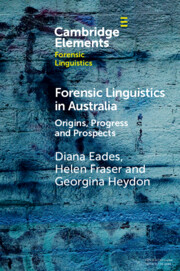Element contents
Forensic Linguistics in Australia
Published online by Cambridge University Press: 23 May 2023
Summary
Keywords
Information
- Type
- Element
- Information
- Series: Elements in Forensic LinguisticsOnline ISBN: 9781009168090Publisher: Cambridge University PressPrint publication: 22 June 2023
References
Accessibility standard: Unknown
Why this information is here
This section outlines the accessibility features of this content - including support for screen readers, full keyboard navigation and high-contrast display options. This may not be relevant for you.Accessibility Information
- 16
- Cited by
